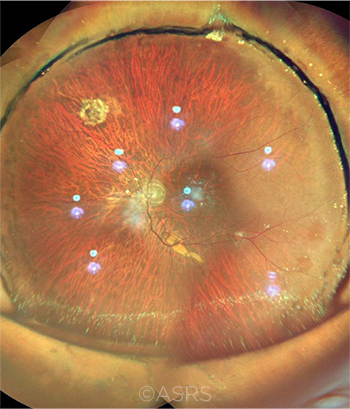Download PDF
How often do patients who undergo incisional ocular surgery fill a prescription for an opioid medication? Despite increased awareness of the opioid crisis in the United States, researchers at the University of Pennsylvania found that the odds of having an opioid prescription filled after ocular surgery was more than 3 times higher in 2014-2016 than in 2000-2001.1
“Though opioid abuse has been declared a public health emergency, until now little has been known about the association between opioids and ocular surgery,” said coauthor Brian L. VanderBeek, MD, MPH, MSCE, at the Scheie Eye Institute in Philadelphia. “The findings of our study provide a basis for discussing the role of opioids in postophthalmic surgical management.”
 |
TYPICAL RECIPIENT. Scleral buckling surgery is one of the top three ocular surgeries for which patients are likely to be prescribed an opioid medication. This image was originally published in the ASRS Retina Image Bank. Manish Nagpal, MD, FRCS (UK), and Gayathri Mohan, Retina Foundation. Buckled Silicone Oil Filled Eye. Retina Image Bank. 2019; Image Number 31131. © The American Society of Retina Specialists.
|
Study specifics. The researchers used medical claims data from a U.S. insurer’s database for the period of January 2000 through December 2016. For the primary analysis, the researchers looked at the rate of filled opioid prescriptions for each ophthalmic subspecialty surgery over time.
Results. A total of 2,407,962 incisional ocular surgeries were included; of these, 45,776 (1.90%) were associated with a filled opioid prescription. The lowest number of filled prescriptions was in 2000-2001, in which 671 prescriptions were filled for 53,912 surgeries (1.24%). In contrast, in 2016, 5,851 prescriptions were filled for 282,106 surgeries (2.07%). Multivariate logistic regression showed that year of surgery was significantly associated with filling an opioid prescription, with the highest odds in 2014 (odds ratio [OR] 3.71), 2015 (OR, 3.33), and 2016 (OR, 3.27).
The highest prescription fill rates were associated with strabismus surgery, trauma, and retina surgery.
Bottom line. These findings suggest the rate of filled prescriptions for opioid medications are increasing for all types of incisional ocular surgery over time, the researchers said. They concluded, “Given the ongoing national opioid epidemic, we hope the trends of increased prescription use we have described will motivate clinicians to evaluate their opioid prescribing practices to help in reversing the epidemic.”
To help reduce unnecessary opioid prescribing, the CDC has published guidelines that cover such topics as risk assessment, drug selection, dosing regimens, and appropriate follow-up.2
—Arthur Stone
___________________________
1 Kolomeyer A et al. JAMA Ophthmol. Published online Sept. 19, 2019.
2 Dowell D et al. MMWR Recomm Rep. 2016;65(1):1-49.
___________________________
Relevant financial disclosures—Dr. VanderBeek: NEI/NIH: S; Paul and Evanina MacKall Foundation: S; Research to Prevent Blindness: S.
For full disclosures and the disclosure key, see below.
Full Financial Disclosures
Dr. Deobhakta Alimera Sciences: C; Allergan: C.
Dr. Etminan None.
Dr. Friedlander None.
Dr. VanderBeek NEI/NIH: S; Paul and Evanina MacKall Foundation: S; Research to Prevent Blindness: S.
Disclosure Category
|
Code
|
Description
|
| Consultant/Advisor |
C |
Consultant fee, paid advisory boards, or fees for attending a meeting. |
| Employee |
E |
Employed by a commercial company. |
| Speakers bureau |
L |
Lecture fees or honoraria, travel fees or reimbursements when speaking at the invitation of a commercial company. |
| Equity owner |
O |
Equity ownership/stock options in publicly or privately traded firms, excluding mutual funds. |
| Patents/Royalty |
P |
Patents and/or royalties for intellectual property. |
| Grant support |
S |
Grant support or other financial support to the investigator from all sources, including research support from government agencies (e.g., NIH), foundations, device manufacturers, and/or pharmaceutical companies. |
|
More from this month’s News in Review